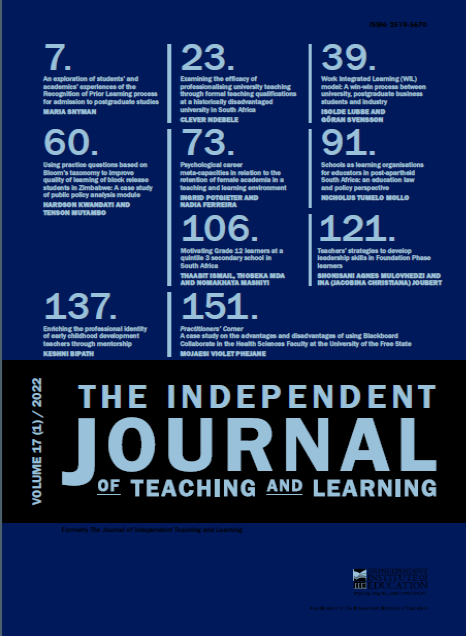Using practice questions based on Bloom’s taxonomy to improve quality of learning of block release students in Zimbabwe: A case study of public policy analysis module
DOI:
https://doi.org/10.17159/1bxz5q72Keywords:
block release, distance teaching, student supportAbstract
The paper observes that nearly all universities in Zimbabwe offer crash academic programmes that are commonly referred to as block release because students attend their face-to-face classes for a short space of time. The Covid-19 pandemic has intensified the use of block release. During block release sessions, students are taught all the course content for the whole semester which usually includes four courses. After the intensive face-to-face lessons, students are expected to write their assignments and then come back to write their final examinations at the end of the semester. The paper contends that the block release mode of instruction is typical distance education and therefore requires continuous student-instructor interaction through use of well-planned practice questions based on the course syllabus. To be effective, the paper suggests that the practice questions should be based on Benjamin Bloom’s taxonomy of questions. The questions focus on key verbs which include remember (or recall), understand, apply, analyse, evaluate and create. This approach enables students to master various types of knowledge which are factual, conceptual, procedural and metacognitive. The paper uses illustrative questions from public policy analysis which is a relatively new discipline in the context of Zimbabwe. The illustrative questions can also be applied across disciplines such as Family and Religious Studies, History and Geography.
References
Africa Virtual University. (2020) Template for writing up your practice-based submission. https://avu. org/avuweb/en/resources-presenters-reviewers/template-for-writing-up-your-practice-based-submission/ (Accessed 20 October 2020).
Anderson, L.W. & Krathwohl, D.R. (Eds.) (2001) A taxonomy for learning, teaching, and assessing: A revision of Bloom’s taxonomy of educational objectives. New York: Addison Wesley Longman.
APA Dictionary of Psychology (2020) Massed practice. https://dictionary.apa.org/massed-practice (Accessed 10 June 2020).
Benjamin, A.S. & Tullis, J. (2010) What makes distributed practice effective? Cognitive Psychology 61(3) pp.228-247. DOI: https://doi.org/10.1016/j.cogpsych.2010.05.004
Carpenter, S.K. & Delosh, E.L. (2006) Impoverished cue support enhances subsequent retention: Support for the elaborative retrieval explanation of the testing effect. Memory & Cognition 34 pp.268–276. DOI: https://doi.org/10.3758/BF03193405
Farajollahi, M. & Moenikia, M. (2010) The study of relation between students support services and distance students’ academic achievement. Procedia Social and Behavioral Sciences 2 pp.4451-4456. DOI: https://doi.org/10.1016/j.sbspro.2010.03.710
Garrison, D.R. (1989) Understanding distance education: A framework for the future. London: Routledge.
Jaakkola, E. (2020) Designing conceptual articles: four approaches. AMS Review 10(1) pp.18-26. DOI: https://doi.org/10.1007/s13162-020-00161-0
Janiszewski, C., Noel, H. & Sawyer, A.G. (2003) A Meta-analysis of the Spacing Effect in Verbal Learning: Implications for Research on Advertising Repetition and Consumer Memory. Journal of Consumer Research 30(1) pp.138-149. DOI: https://doi.org/10.1086/374692
Kapler, I. V., Weston, T. & Wiseheart, M. (2015) Spacing in a simulated undergraduate classroom: Long-term benefits for factual and higher-level learning. Learning and Instruction 36 pp.38-45. DOI: https://doi.org/10.1016/j.learninstruc.2014.11.001
Kornell, N. (2009) Optimising Learning Using Flashcards: Spacing is more effective than cramming. Applied Cognitive Psychology pp.1297-1317. DOI: https://doi.org/10.1002/acp.1537
Moore, M.G. (1993) Theory of transactional distance. In D. Keegan (Ed.) Theoretical Principles of Distance Education (pp.22-38). London: Routledge.
Pickard, M.J. (2007) The new Bloom’s taxonomy: An overview for family and consumer sciences. Journal of Family and Consumer Sciences Education 25(1) pp.43-55.
Rawson, K.A. & Kintsch, W. (2005) Rereading effects depend on time of test. Journal of educational psychology 97(1) pp.70-80. DOI: https://doi.org/10.1037/0022-0663.97.1.70
Rohrer, D. & Taylor, K. (2007) The shuffling of mathematics problems improves learning. Instructional Science 35(6) pp.481-498. DOI: https://doi.org/10.1007/s11251-007-9015-8
Rumble, G. (2000) Student support in distance education in the 21st century: learning from service management. Distance Education 21(2) pp.216-235. DOI: https://doi.org/10.1080/0158791000210202
Sewart, D. (1993) Student support system in distance education. Open Learning 8(3) pp.3-12. DOI: https://doi.org/10.1080/0268051930080302
Shale, D. & Garrison, D.R. (1990) Introduction. In D.G.D.R. Shale (Ed.) Education at a distance (pp. 1-6). Malabar, FL: Robert E. Kriger.
Simmons, A.L. (2012) Distributed practice and procedural memory consolidation in musicians’ skill learning. Journal of Research in Music Education 59(4) pp.357-368. DOI: https://doi.org/10.1177/0022429411424798
Smolen, P., Zhang, Y. & Byrne, J.H. (2016) The right time to learn: mechanisms and optimization of spaced learning. Nature Reviews Neuroscience 17(2) pp.77-88. DOI: https://doi.org/10.1038/nrn.2015.18
Tabor, S.W. (2007) Narrowing the Distance: Implementing a Hybrid Learning Model. Quarterly Review of Distance Education 8(1) pp.48-49.
Tofade, T., Elsner, J. & Haines, S.T. (2013) Best practice strategies for effective use of questions as a teaching tool. American journal of pharmaceutical education 77(7) pp.1-9. DOI: https://doi.org/10.5688/ajpe777155
Vaughan, N. (2010). A blended community of inquiry approach: Linking student engagement to course redesign. Internet and Higher Education 13(1-2) pp.60-65. DOI: https://doi.org/10.1016/j.iheduc.2009.10.007
Voluntary Sector Review (2017) Advice for preparing Practice Papers for the Journal Voluntary. https://policy.bristoluniversitypress.co.uk/asset/4589/what-is-a-practice-paper-sept-2017.pdf (Accessed 20 October 2020).
Whetten, D. (1989) What constitutes a theoretical contribution? Academy of Management Review 14 pp.490-495. DOI: https://doi.org/10.5465/amr.1989.4308371
Zigerell, J. (1984) Distance education: An information age approach to adult education (No. 283). ERIC Clearinghouse on Adult, Career, and Vocational Education, National Center for Research in Vocational Education: Ohio State University, US.
Downloads
Published
Issue
Section
License
Copyright (c) 2022 The Independent Journal of Teaching and Learning

This work is licensed under a Creative Commons Attribution 4.0 International License.






.png)